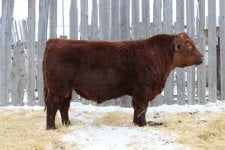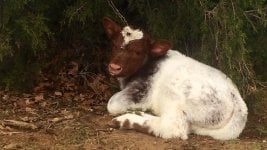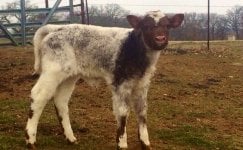In regards to the EPDs on Shadybrook Optimum 75F changing to suggest he is an easier calving sire than his EPDs suggested in the past, I would say it is about time! Optimum was born 18 years ago and he is still considered to be in the top 2 calving ease bulls I have ever used. I used him on heifers for several years and I never assisted a single birth from him. What I also liked was that his calves were all polled, dark colored and saleable. Every bull calf I had from him was sold as a breeding bull. It just seems to have taken far too long to start to see his numbers move in the direction I think they should be moving. I don't think any breeder can wait a decade or more to see accurate numbers depicted. I will agree that the EPDs shown for Optimum are probably fairly close to correct, but the fact that remains is why did it take at least 15 years to see this happen? It is 17 years ago that I first used him on heifers and I know he was used by several other breeders as well back then, yet everyone who used him was impressed with his calving ease but his EPDs barely moved.
Also in regards to the situation I wrote about above, I guess I don't understand enough about how these EPDs are derived, but the answers this man was given by the ASA of why his bull moved from a BW EPD of 2.0 to 5.5 in a few brief months, makes little sense to me. I looked up his pedigree and there are NO animals in his pedigree, that have a BW EPD of 5.5. There is NO animals with a BW EPD of more than 3.8 in the first 3 generations of his pedigree. His sire has a BW EPD of 3.4. His dam has a BW EPD of 2.8, both of which are quite aways from a 5.5. If the way the data was submitted can affect what the EPD number is, I truly think there is far too many ways to manipulate the system then.
Last week I had a heifer calf born out of a first calf heifer that is sired by a bull listed in Jaimie's table. The sire is considered to be a calving ease sire. This was an AI calf and there was no clean up bull used for about 2 months after this breeding, but this heifer calf weighed 126 lbs at birth. From the AI date, this heifer actually calved several days early, and I was not expecting her to calf. It was -38 C the morning she calved and I pulled the calf as I was not sure how long she had been working at calving. It was an easy pull( I pulled it by hand) and I am pretty certain she would have calved unassisted if I had left her alone. The fact remains that this calf weighed 126 lbs. I have told the owner of the sire but I am not going to mention the bulls name. That really should not matter as this discussion is about the EPDs. This sire has a Calving ease EPD of -1.0. His BW EPD is -1.1. The two year old dam has a calving ease EPD of 2.9 and a BW EPD of 2.2. When I look at these numbers I would never expect to get a 126 lb heifer calf from combining these two animals. This is the biggest BW I have had in at least 5 or 6 years here, and I know that if this had been a male calf, he would already be a steer.
I guess I am just looking for someone to give me some answers that make some sense. I don't understand how a bull calf that was born unassisted from a two year old female with a BW EPD of 2.8 and a sire with a BW EPD of 3.4 can have a BW EPD of 5.5 and the only reason the owner is given is because he did not submit a large enough contemporary group when he submitted his data. To me, that makes no sense... absolutely none. In fact, It makes me question virtually every number I look at.
I started these remarks after looking through the list of sires that Jaimie posted. I am pretty sure some of them are probably pretty accurate. My problem is if there is others that look suspicious, then how do I trust the numbers when I make any selection? Again, I am not going to mention sire names, as I do not own some of the sires that made me scratch my head. One of the sires I was referring to, is in my opinion, one of the easiest calving bulls I have ever used, and I would not hesitate to use him on heifers. When I saw another bull listed here, that I consider to NOT be a calving ease sire in my experience with him, and then see that both these bulls have very similar CE and BW numbers I again question the validity. I understand that there can be differences in calving ease between herds, but it makes me also wonder how I ( or anyone else) can use these EPDs with some confidence. I see more and more people ( especially younger breeders) selecting breeding stock by the numbers and I only ask the question, " are they doing the right thing"? I would love to be able to put my trust in computer generated numbers like these people do, but I continually run into things that I cannot explain, and make little sense to me. I am thinking somewhere there should be a common sense EPD generated.
When the owner of the bull who moved from 2.0 to 5.5 is told that if he had submitted his data differently, he may have had a different result in the bulls EPDs, just how on God's Green Earth am I supposed to know that when I go to a bull sale and look at his numbers in a sale catalog. There are some things in life that seem to make sense in theory but don't seem to when they are submitted to reality. I hope these EPDs are not one of these, as they are driving most every breed out there.



